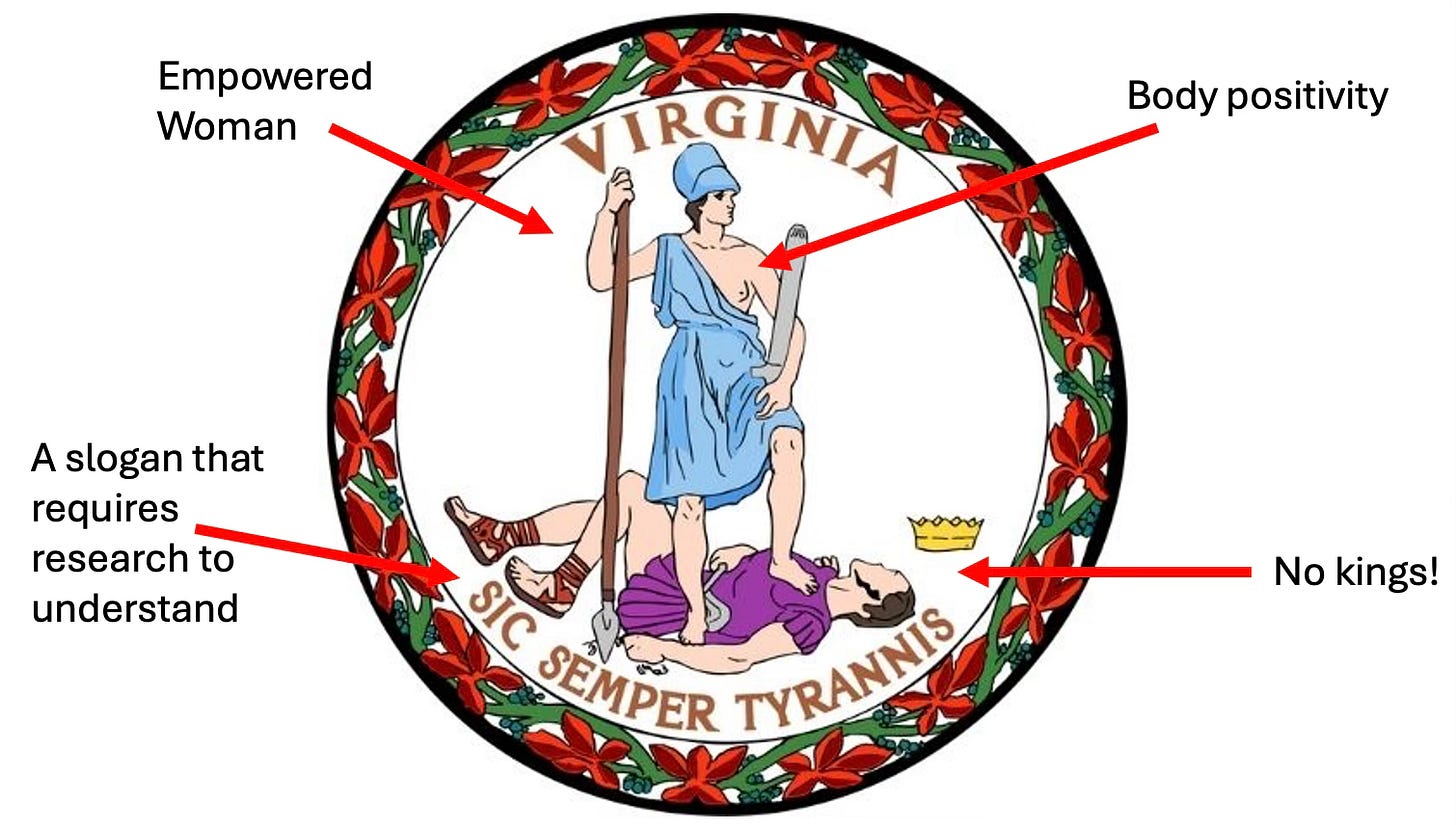Why Every Revolution Needs a Good Graphic Designer
Flags, party symbols, and aspirational marketing in politics.

My son has unique interests for an eleven-year-old. One of them is vexillology. Never heard of it? Until recently, I hadn’t either.
Vexillology is the study of flags and their design. Like every niche interest, a corner of the internet caters to those who obsess over flags. A community generally known as vexillophiles. To bond with my son, I sit next to him on the couch and watch YouTube videos about the subject.
I have come to learn there are people who harbor strong opinions about what constitutes good and bad flag design. Good flags follow 23 principles established by The Commission's Report on the Guiding Principles of Flag Design. The guidelines, among other things, encourage simple designs, distinctive symbols, fewer colors. They discourage the use of text, realistic imagery, and color gradients.
U.S. state flags frequently violate these principles and work the vexillophiles into a hot lather. New Mexico’s flag is one of a handful they hold in high esteem. It features a red Zia sun symbol on a yellow background to honor the state's indigenous heritage. On the other hand, they rank Virginia’s as one of the worst.
It consists of the Commonwealth’s seal on a blue background. Under the word Virginia, an Amazonian woman with her left breast exposed stands atop a dead king, a spear grasped in her right hand. Underneath the lifeless body is Virginia’s motto, Sic semper tyrannis, which means "Thus always to tyrants.” In other words, tyrants will always be overthrown.
While the vexillophiles hate Virginia’s flag for its busy design and gratuitous use of text, it holds the dual distinction of being the only U.S. state flag depicting nudity and murder. I think that should count for something. It’s a fine display of aspirational marketing, if you ask me (which you didn’t).
Aspirational marketing is an advertising technique whereby you spin stories about dreams and possibilities. For example, if you are selling a pickup truck, instead of listing off a new truck’s features compared to competitors’ models, you show an idealized lifestyle of the truck’s owner. He’s driving the vehicle over mountainous terrain, towing a boat to the lake, or getting work done on a construction site. The technique assumes the consumer is purchasing the product to achieve a dream. It taps into emotions instead of economic calculus and rational decision-making.
New Mexico’s flag, while aesthetically more appealing, doesn’t evoke emotion. It doesn’t sell a dream, or at least not one that I can discern. Which reminds me of the Democratic Party’s symbols: the donkey and the capital D inside a circle.
The donkey owes its status to President Andrew Jackson. His opponents liked to call him a “jackass.” He thought that was swell and approvingly slapped the donkey onto his 1828 presidential campaign posters. Thomas Nast, a political cartoonist, would go on to reinforce the donkey as a Democratic Party symbol throughout the second half of the 1800s. However, it wasn’t until the 1930s when Democrats adopted the donkey as an official party symbol.
The donkey is still around, but in an unofficial capacity, and was refreshed this year to look more like a piñata. The official Democratic Party logo is this bad boy which was rolled out in 2010:

The D inside a circle is the result of 1) form over function—it checks all the vexillology boxes but manages to say nothing; and 2) group thinking that offends no one. I imagine a marketing firm presented a number of options to a committee. After much debate, the committee devolved to the lowest common denominator. Consequently, as a symbol, the capital D evokes nothing, asks nothing, and stands for nothing. It should be replaced. With what you ask?
My simple answer is aspiration. I invite readers to close their eyes (not yet) and recall the pickup truck ad I described earlier. Instead of the truck, the Democratic Party is the product. What do you see? What dream are you living in if you buy the Democratic Party’s vision for America? Close them peepers now.
In all honesty, I struggle to imagine a coherent picture; whereas, I see the Republicans' fantasy land with 20/20 vision. It’s playing out on the television and internet every day, and in the news.
The Republican Party has largely dumped its old branding. They realized the elephant lacked emotional charge. In an age of loosening and shifting political party affiliations, the pachyderm is a relic of a bygone era. MAGA is its replacement.
MAGA is aspirational marketing. It sells an idealized past where America was great. A longing for a mythical time when everything was perfect. Not only that, but it’s an emotion: nostalgia.
I close my eyes and see white people, a concocted Christianity that turns love thy neighbor into a license to hate. I see soldiers in our streets, chaos, might equals right, indifference to suffering, and women consigned to society’s fringe. It is fear mixed with the 1950s television show Leave it to Beaver.
What do I wish to see instead? Eventually: prosperity, kindness, community, freedom, humility, and pluralism. Right now? A half-naked Amazonian warrior shoving her spear into a tyrant.
Blake
Welcome to the Postscript
The Postscript is a compilation of jokes and interesting tidbits constructed from material I deemed tangential to the final draft.
PS — Virginia’s seal was made in 1776. The dead tyrant is representative of King George III. However, John Wilkes Booth wrote in his diary that he shouted the words Sic semper tyrannis as he shot Abraham Lincoln in Ford’s Theater.
PPS — I think Democrats should embrace and appropriate a number of revolutionary and rebel flags. For example, if you slap a rainbow on the Gadsden Flag, its coiled rattlesnake and ‘Don’t tread on me’ take on a whole new vibe. Bonus points for trolling.
Triple Ps — There is a lot here for Democrats to like:





Hahahahahahahahahaha